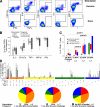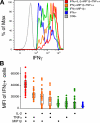Immunization with vaccinia virus induces polyfunctional and phenotypically distinctive CD8(+) T cell responses
- PMID: 17535971
- PMCID: PMC2118607
- DOI: 10.1084/jem.20062363
Immunization with vaccinia virus induces polyfunctional and phenotypically distinctive CD8(+) T cell responses
Abstract
Vaccinia virus immunization provides lifelong protection against smallpox, but the mechanisms of this exquisite protection are unknown. We used polychromatic flow cytometry to characterize the functional and phenotypic profile of CD8(+) T cells induced by vaccinia virus immunization in a comparative vaccine trial of modified vaccinia virus Ankara (MVA) versus Dryvax immunization in which protection was assessed against subsequent Dryvax challenge. Vaccinia virus-specific CD8(+) T cells induced by both MVA and Dryvax were highly polyfunctional; they degranulated and produced interferon gamma, interleukin 2, macrophage inflammatory protein 1beta, and tumor necrosis factor alpha after antigenic stimulation. Responding CD8(+) T cells exhibited an unusual phenotype (CD45RO(-)CD27(intermediate)). The unique phenotype and high degree of polyfunctionality induced by vaccinia virus also extended to inserted HIV gene products of recombinant NYVAC. This quality of the CD8(+) T cell response may be at least partially responsible for the profound efficacy of these vaccines in protection against smallpox and serves as a benchmark against which other vaccines can be evaluated.
Figures







References
-
- Edghill-Smith, Y., H. Golding, J. Manischewitz, L.R. King, D. Scott, M. Bray, A. Nalca, J.W. Hooper, C.A. Whitehouse, J.E. Schmitz, et al. 2005. Smallpox vaccine-induced antibodies are necessary and sufficient for protection against monkeypox virus. Nat. Med. 11:740–747. - PubMed
-
- Riddell, S.R., and P.D. Greenberg. 1995. Principles for adoptive T cell therapy of human viral diseases. Annu. Rev. Immunol. 13:545–586. - PubMed
-
- Schmitz, J.E., M.J. Kuroda, S. Santra, V.G. Sasseville, M.A. Simon, M.A. Lifton, P. Racz, K. Tenner-Racz, M. Dalesandro, B.J. Scallon, et al. 1999. Control of viremia in simian immunodeficiency virus infection by CD8+ lymphocytes. Science. 283:857–860. - PubMed
Publication types
MeSH terms
Substances
Grants and funding
LinkOut - more resources
Full Text Sources
Other Literature Sources
Medical
Research Materials

